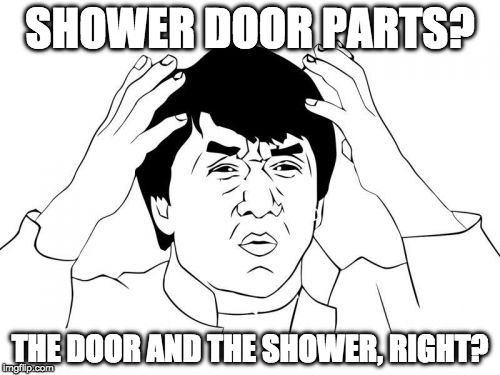Unraveling The Mystery: What Are The Parts of A Shower Door?


My knowledge of shower doors is limited to opening an closing them when I take a shower. If you and I are on the same boat, then, phew, we're good. It's easy to observe something and say, "Hey, that's a shower door," but it's not the same thing to identify all of its parts, and what each part does, and how each part relates to each other. That's why we're gonna decipher the mystery of the shower door by identifying its parts and explaining in human language what each one does. I say human language because I'm no expert, but I know that by the end of this you and I will know exactly how a shower door works. So let's get to it!
Note: I have attached a link to DK Hardware's inventory on each part's name below so you can reference it to get an idea of what the parts look like or maybe even to see if you recognize them.
Shower Door Parts
Hinges are used for wall-mounted shower doors. They are screwed into wall and the glass is attached to them. Hinges, just like the ones on regular doors, facilitate the open/close mechanism of the shower door, so they are flexible yet reliable as well.
Pull handles and knobs are installed on the glass to manipulate the open/close or sliding mechanism of the shower door. They function like any handle or knob on any other door, so no mystery here. Well, you only push or pull the knob, so don't break it trying to twist it.
Towel and grab bars are pretty special because they have many functions. You can use them to hang your towel for easier reach, to open/close or slide the door, or hold on to dear life if the floor is slippery. They can be attached on the inside or outside of the glass, or even on both. Your choice.
Clamps and brackets are used to secure the glass and prevents it from moving out of the track structure. They are attached to the glass directly. Specifically, some brackets are used to attach the roller, which helps the glass slide.
Channels, headers, and thresholds are the tracks that hold the glass in place and through which the glass slides from side to side in order to open and close the finished shower door. It is important to know which ones go on the bottom and the top of the glass. Also, they need to be the exact measurement appropriate for your shower. Good news is DK Hardware can cut these to the measurement you need so you don't have to do it yourself.
Wipes and seals are used to, sorry but that's literally it, seal the shower door. Come on, folks, it's literally that. Wipes and seals are the end of the process, like putting the red ribbon on a gift. They prevent leaky shower doors by keeping the water inside the shower and out of your floor.
Tub enclosure hardware are the small parts that deal with the operation of the finished shower door structure. They kind of tie the whole operation together. For example, tub enclosure hardware includes the roller attached to the glass which helps it slide from side to side, the guide which ensures the smooth movement of the glass and keeps it on track, and the catch which, as the name explains, "catches" the door when it is closed so it doesn't suffer too much of an impact.
I hope you have learned about shower doors as much as I did while doing this project. Please don't hesitate to comment below if you have any questions or further doubts.